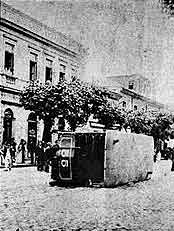
Streetcar turned over
after the revolt
"Urban reforms" were aimed not just at modernizing cities' infrastructure but at transforming their class and racial composition. Over the course
of the 1800s, workers had crowded into decaying colonial-era mansions and
houses that had been subdivided into tenements that went by different names in
different countries: Conventillos (little convents) in Argentina and Uruguay; corticos (beehives) and cabecas de porco (hogsheads) in Brazil; solares (mansions) in
Cuba. As the export boom attracted growing numbers of migrants to the region's
cities, these urban slum communities grow as well. Their overcrowding and crude
sanitary conditions contributed to high urban death rates, crime, and occasional
outbreaks of epidemic disease that threatened all city dwellers. And throughout
Afro-Latin America, they were heavily black and mulatto. In Brazil and Cuba,
where thousands of recently freed libertos sought to escape their recent servitude
by moving to the cities, they were overwhelmingly so. Surveys of Havana slums
found that 9S percent or more of their inhabitants were black and mulatto. In
Rio de Janeiro, black migrants from Bahia streamed into the center-city neighborhood
next to the docks, which became known as Little Africa. As that neighborhood
filled up, other Bahian migrants buill Rio's first favela, a community of
makeshift huts and shacks on a hill behind the Ministry of War. Over the course
of the 1900s, favelas spread throughout the city and became a ubiquitous form of
housing for the poor, who, as at the turn of the century. were predominantly
Afro-Brazilian.
It was largely in order to remove poverty and blackness from the city center
that the federal government demolished and rebuilt much of Rio's downtown in
the early 1900s, expelling the corticos' inhabitants to squalid, remote suburbs
along the railroad line north of the city. Center-city residents fought back with
the Vaccine Revolt, a week of urban riots in 1904. The immediate cause of the rebellion
was a government campaign to vaccinate the population against smallpox,
in which health officials entered working-class homes, often without permission,
and inoculated every member of the family. Poor families reacted
angrily to this aggressive state intrusion into the home, and they protested as well
the destruction of inner-city neighborhoods that had provided affordable housing
near their places of work. Many, perhaps most, of the rioters were Afro-Brazilian.
As one such protestor was carried off to jail. he shouted to the crowd that he
was fighting "to show the government that it can't put its foot on the people's
neck .... Every now and then it's good for black folk to show that we know how to
die like men!"
Federal troops and police easily put down the Vaccine Revolt, and the government
pushed on with its program of urban renewal. Ultimately, however, Latin
American governments' ability to rebuild their urban centers was limited.

